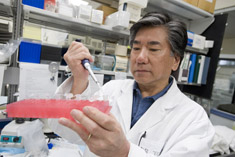Get some guys together. Serve drinks. Then add females to the mix, and watch for a change in the male drinking patterns.

That’s what researchers have been doing at the Rutgers Center of Alcohol Studies. Only instead of people, they’ve used rodents. And rather than serving gin and tonics, they’ve provided pure alcohol, or ethanol, through a sipping tube.
The studies provide researchers with a vivid picture of the way deeply ingrained social pressures serve as triggers to alcohol use – and abuse. And that helps them better understand the forces that lead to alcoholism in humans.
“We’ve seen consistently that the males drink more when there are females around, and the females drink more when the males are around,” said Professor Arthur Tomie, a psychology professor and an affiliated faculty member with the center. “And by looking at this we can better understand what happens with people; we can understand, for example, how the tendency to binge is likely to occur in mixed company.”
Tomie’s research in this area began several years ago with a breakthrough study that looked at the drinking patterns of male rats housed in an experimental chamber equipped with ethanol tubes and a sliding guillotine door. Researchers would raise the door and expose one group to a female, and another group to a male. A third group was exposed to a female but had water – rather than ethanol – in the sipping tube.
The results showed that when the fluid in the sipping tube had the highest level of ethanol content (10 percent), the rats exposed to the female drank about 55 percent more than those exposed to the male. Those rats also drank about four times as much as the group supplied with water.
In addition, all the rats exposed to the opposite sex had far higher levels of the hormone corticosterone, which indicates high stress levels, and which has been shown to trigger alcohol consumption.
“Alcohol is an anti-anxiety drug, and a profound one, particularly with respect to social stress,” Tomie said.
Such research puts Rutgers in the vanguard of alcohol studies because few other universities are looking at the impact of opposite gender.
“We were very surprised that there’s little literature on the effect of one gender on the other gender,” Tomie said. “When you see studies on gender and alcohol, it’s typically a comparison of male and female. Who drinks more?”
The studies continued in the spring 2010 semester, when Tomie and a group of undergraduates focused on mice, and the reaction of both genders to the same and opposite sex. This time, the mice were paired off and placed in small cages. And once again, those exposed to the opposite sex drank more than those who were not, Tomie said.
Alyssa DeFuria, a psychology major who compiled the statistical data for the studies, said the research was intriguing because it debunked the ‘fraternity theory’ that men drink out of male bonding.
“You always hear that ‘boys will be boys’ and that men drive each other to drink,” DeFuria said. “In fact, they don’t.”
She also said the research could be of tremendous help to clinicians as they examine how troubled relationships create a fertile ground for alcohol abuse.
The Center of Alcohol Studies, located on the Busch Campus, is the first interdisciplinary research center devoted to alcohol use and alcohol-related problems and treatment. The center led the movement to recognize alcoholism as a major public health problem and to have the American Medical Association accept alcoholism as a treatable illness, a policy it formally adopted in the 1950s.
Researchers at the center study alcohol from a range of academic disciplines, including neurobiology, pharmacology and genetics.
The studies on gender effect will continue in the fall semester, when Tomie will again look at mice, but with a larger sample from multiple breeds.
“You are going to have a lot of diversity between individuals,” he said.